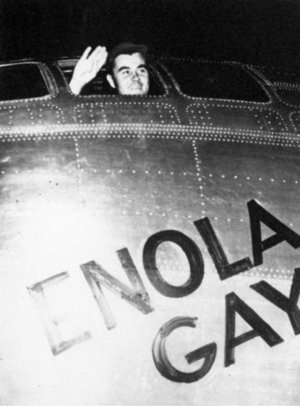Enola Gay
|
|
Enola Gay was a B-29 Superfortress 44-86292 bomber of the U.S. Army Air Force that dropped the first atomic bomb ever used in warfare ("Little Boy"). The Enola Gay dropped the atomic bomb on Hiroshima, Japan on August 6, 1945, just before the end of World War II. The Enola Gay became famous for its part in the atomic bombing of Hiroshima. In the past it was displayed in the National Air and Space Museum of the Smithsonian Institution in Washington, D.C., but that exhibit closed on May 18, 1998. In 2003, the Enola Gay was once again viewable to the public at the Steven F. Udvar-Hazy Center at Dulles International Airport.
The Enola Gay was assigned to the U.S. Army Air Force's 509th Composite Group and flew the August 6 mission out of Tinian, a small island in the Mariana Islands chain. The plane was one of only 15 B-29s modified to deliver nuclear bombs; its crew had undergone training at Wendover Army Air Field in Wendover, Utah.
Enola_Gay_cockpit.jpg
Colonel Paul Tibbets, the plane's pilot, named her after his mother Enola Gay Tibbets (who in turn was named after the heroine of a novel). The Enola Gay was followed only three days later by another B-29 (Bockscar) (piloted by Chuck Sweeney) which dropped a second nuclear weapon, "Fat Man," on Nagasaki. These two bombs were the only nuclear bombs ever used as offensive weapons.
The plane has been fully restored and is currently displayed as a major permanent exhibit at the National Air and Space Museum's Steven F. Udvar-Hazy Center at Dulles International Airport near Washington, D.C. Its exhibition there, as well as the previous partial presentation in the original Smithsonian Air and Space Museum on the National Mall, has been met with controversy. The airframe's instrumental role in the atomic bombings led many to challenge the Smithsonian's presentation displays around the aircraft. Some individuals, including many Hiroshima survivors, have called for more comprehensive language detailing the destruction caused by the bomb. The Smithsonian has largely refused to elaborate the language presented on the signage, on the basis that all aircraft in the museum are presented with the same succinct technical data.
Enola_gay_20040710_170220_1.4.jpg
The Enola Gay's crew on August 6, 1945 consisted of twelve men:
- Colonel Paul Tibbets–pilot
- Captain Robert Lewis–copilot
- Major Thomas Ferebee–bombardier
- Captain Theodore Van Kirk–navigator
- Lieutenant Jacob Beser–radar countermeasures (also the only man to fly on both nuclear bombing missions)
- U.S. Navy Captain William Sterling "Deak" Parsons–weaponeer
- Second Lieutenant Morris R. Jeppson–assistant weaponeer
- Sergeant Joe Stiborik–radar
- Staff Sergeant George Caron–tail gunner
- Sergeant Robert Shumard–assistant flight engineer
- Private First Class Richard Nelson–radio
- Technical Sergeant Wayne Duzenberry–flight engineer
External links
- The Smithsonian's site on the Enola Gay includes links to crew lists and other details (http://www.nasm.si.edu/exhibitions/gal103/gal103_former.html)
- Paul Tibbets' web site dedicated to the plane (http://www.theenolagay.com)
Song
In 1980, the British synth pop band OMD had a big hit in Europe with a song entitled Enola Gay (from the Organisation LP), based on the Hiroshima bombing.de:Enola Gay es:Enola Gay fr:Enola Gay nl:Enola Gay ja:エノラ・ゲイ pl:Enola Gay

